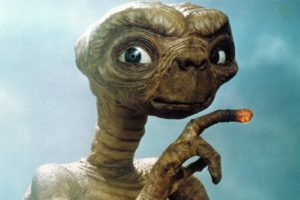Human beings have never encountered extra-terrestrials, but we’ve been imagining them for thousands of years
The Wall Street Journal, March 7, 2019

Fifty years ago this month, Kurt Vonnegut published “Slaughterhouse-Five,” his classic semi-autobiographical, quasi-science fiction novel about World War II and its aftermath. The story follows the adventures of Billy Pilgrim, an American soldier who survives the bombing of Dresden in 1945, only to be abducted by aliens from the planet Tralfamadore and exhibited in their zoo. Vonnegut’s absurd-looking Tralfamadorians (they resemble green toilet plungers) are essentially vehicles for his meditations on the purpose of life.
Some readers may dismiss science fiction as mere genre writing. But the idea that there may be life on other planets has engaged many of history’s greatest thinkers, starting with the ancient Greeks. On the pro-alien side were the Pythagoreans, a fifth-century B.C. sect, which argued that life must exist on the moon; in the third century B.C., the Epicureans believed that there was an infinite number of life-supporting worlds. But Plato, Aristotle and the Stoics argued the opposite. In “On the Heavens,” Aristotle specifically rejected the possibility that other worlds might exist, on the grounds that the Earth is at the center of a perfect and finite universe.
The Catholic Church sided with Plato and Aristotle: If there was only one God, there could be only one world. But in Asia, early Buddhism encouraged philosophical explorations into the idea of multiverses and parallel worlds. Buddhist influence can be seen in the 10th-century Japanese romance “The Bamboo Cutter,” whose story of a marooned moon princess and a lovelorn emperor was so popular in its time that it is mentioned in Murasaki Shikibu’s seminal novel, “The Tale of Genji.”
During the Renaissance, Copernicus’s heliocentric theory, advanced in his book “On the Revolutions of the Celestial Spheres” (1543), and Galileo’s telescopic observations of the heavens in 1610 proved that the Church’s traditional picture of the cosmos was wrong. The discovery prompted Western thinkers to imagine the possibility of alien civilizations. From Johannes Kepler to Voltaire, imagining life on the moon (or elsewhere) became a popular pastime among advanced thinkers. In “Paradise Lost” (1667), the poet John Milton wondered “if Land be there,/Fields and Inhabitants.”
Such benign musings about extraterrestrial life didn’t survive the impact of industrialization, colonialism and evolutionary theory. In the 19th century, debates over whether aliens have souls morphed into fears about humans becoming their favorite snack food. This particular strain of paranoia reached its apogee in the alien-invasion novel “The War of the Worlds,” published in 1897 by the British writer H.G. Wells. Wells’s downbeat message—that contact with aliens would lead to a Darwinian fight for survival—resonated throughout the 20th century.
And it isn’t just science fiction writers who ponder “what if.” The physicist Stephen Hawking once compared an encounter with aliens to Christopher Columbus landing in America, “which didn’t turn out very well for the Native Americans.” More hopeful visions—such as Steven Spielberg’s 1982 film “E.T. the Extraterrestrial,” about a lovable alien who wants to get back home—have been exceptions to the rule.
The real mystery about aliens is the one described by the so-called “Fermi paradox.” The 20th-century physicist Enrico Fermi observed that, given the number of stars in the universe, it is highly probable that alien life exists. So why haven’t we seen it yet? As Fermi asked, “Where is everybody?”





